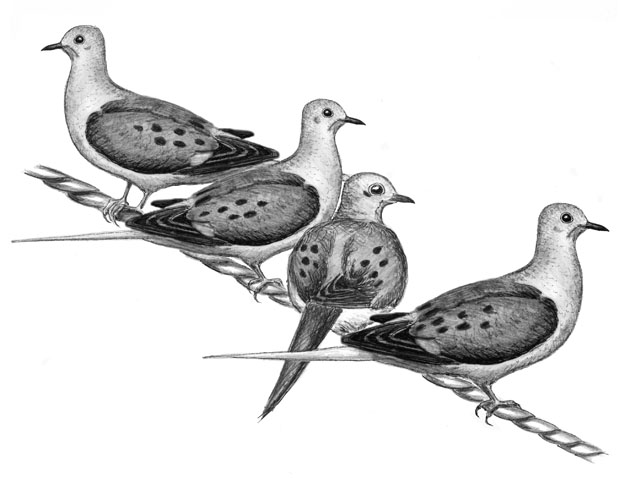
Dear Bird Folks,
I think I’ve asked this question before, but since you never answered it I’m asking it again. Why do birds sit on telephone lines? With all the trees around I would think they’d rather sit on branches. No?
– Ann, Dennis, MA
Shhh, Ann,
The reason I didn’t answer your question the first time is because I’m not supposed to share this information with anyone. You see, the birds that sit on wires are spies, or at least they used to be. Back in the day when the Communists were taking over the country, and everyone was worried about the Red Scare, Joe McCarthy trained birds to sit on phone lines and listen to our conversations. Through vibrations in their feet the birds could hear what folks were saying. They would then report any suspicious info to the Committee on Un-American Activities. This program lasted for years until the advent of cell phones, which made the program obsolete. The introduction of wireless calling has eliminated the need for telephones lines. Now the birds have no place to sit. And in an ironic twist, these cell phones are being made in world’s largest Communist country. Even with all of his spies, I’ll bet Joe didn’t see that coming.
I’m glad you asked about this behavior, Ann, because it’s one of my favorite subjects. The behavior is called “loafing” and it’s very important to birds…and me, too. I love loafing. Reading, watching TV and even napping sound like a lot more work than just loafing. People say, “I have to go take a nap.” It seems like an assignment. But loafing is the ultimate in laziness. No one has to go loaf; they just do it. While loafing is kind of a nice treat for us, it’s a critical activity for birds. They can’t fly all the time. They have to slow down and chill at some point and when they do it’s called “loafing.” (I know we established what loafing is a few sentences earlier, but I couldn’t think of another way to end this paragraph.)
Outside of breeding and migrating, birds have one major daily activity and that’s to look for food. Once they have filled up their tanks they need to go somewhere and take a break. During this rest period the birds digest their food, preen their feathers, perhaps cough up a pellet and poop a little, or a lot. Birds loaf in a variety of locations: tree cavities, dense thickets, wide-open beaches, thick branches, or the ground, and as you have noticed, power lines. Mourning Doves seem especially attracted to wires. Out in front of our shop, high above the busy street traffic, there’s nearly always a dove or two sitting on the wires just watching the world go by, and waiting for a fancy car to pass underneath so they can have a little target practice. Historically, doves lived on grasslands and in open areas. Perhaps because of that doves often rest in exposed areas. In the old days the birds rested on uncovered branches, but now they use the ubiquitous utility wires. Sitting right out in the open seems a little dangerous to me, but then again, doves aren’t exactly Rhodes Scholars. Or perhaps they know what they are doing. Resting high above the ground protects the doves from terrestrial predators. Plus, the vantage point allows them to spot danger well in advance. Maybe they are Rhodes Scholars after all.
Another bird that loves to sit on wires is the Tree Swallow. Swallows are extremely gregarious. They can’t get enough of each other. In the fall hundreds of these birds can be seen crowding onto wires. In this case, perhaps, the swallows choose power lines over trees because the wires can accommodate their massive flocks. They use power lines in the same way people use Elks Lodges for parties. They aren’t the most attractive places, but they’re cheap, they hold a lot and they’re everywhere.
One bird that also likes power lines doesn’t necessarily use them to rest or to gather. The little American Kestrel, Cape Cod’s once common falcon, loved it when power companies put up transmission lines. Kestrels like to hunt by sitting high above the ground and patiently waiting for prey to expose itself. The clear-cut area beneath the power lines makes for ideal hunting grounds and the wires are perfect places for the birds to sit, watch and wait. (BTW, when I wrote about prey “exposing itself,” you know what I meant, right?)
In recent years Double-crested Cormorants have also started using power lines. Cormorants often loaf by sitting on rock jetties, wooden piers and fancy boats, which the boat owners don’t like for some reason. At night, however, the birds need to find a safer place to sleep. In some locations, the cormies (not be confused with Joe McCarthy’s Commies) have started roosting on the power lines that are strung across ponds and lakes. By roosting on wires, well above the water, the birds can sleep in peace without having to worry about attacks from land predators, or those irate boat owners I mentioned earlier.
Loafing, hunting and roosting are some of the reasons birds use telephone wires. Birds also use wires simply because they are handy. Their small feet are able to comfortably grab power lines and their abundance makes them a convenient landing option. Sorry you had to ask me twice before I responded, Ann. But what do you expect from someone whose favorite activity is loafing? It’s yet another thing that birds and I have in common.